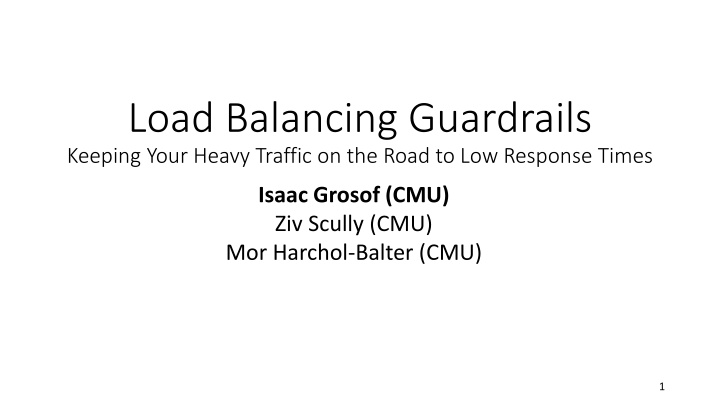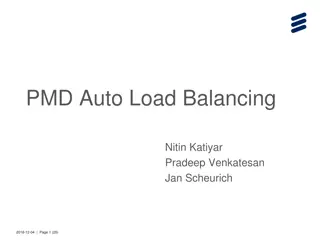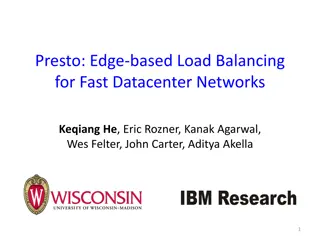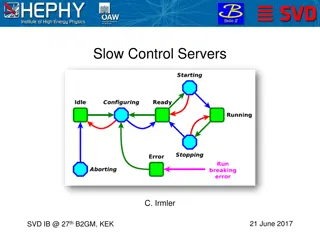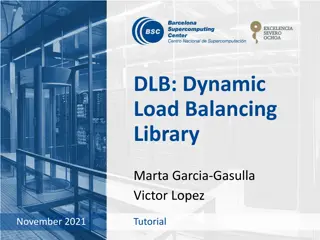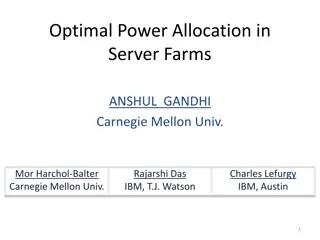Load Balancing Guardrails for Optimal Server Performance
This research delves into the realm of load balancing guardrails, with the primary goal being to maintain heavy traffic on the road towards achieving low response times. The study focuses on optimal load balancing, exploring stochastic arrivals, known sizes, and preempt-resume scenarios. It addresses questions concerning dispatching objectives and scheduling methods, emphasizing the significance of minimizing mean response time. The work presents insights on prior dispatching approaches and sheds light on techniques such as First-Come-First-Serve (FCFS) and Shortest Remaining Processing Time (SRPT). The research contributes unique guardrails to optimize server performance under heavy traffic scenarios, providing a framework for guaranteed optimal outcomes.
Download Presentation

Please find below an Image/Link to download the presentation.
The content on the website is provided AS IS for your information and personal use only. It may not be sold, licensed, or shared on other websites without obtaining consent from the author.If you encounter any issues during the download, it is possible that the publisher has removed the file from their server.
You are allowed to download the files provided on this website for personal or commercial use, subject to the condition that they are used lawfully. All files are the property of their respective owners.
The content on the website is provided AS IS for your information and personal use only. It may not be sold, licensed, or shared on other websites without obtaining consent from the author.
E N D
Presentation Transcript
Load Balancing Guardrails Keeping Your Heavy Traffic on the Road to Low Response Times Isaac Grosof (CMU) Ziv Scully (CMU) Mor Harchol-Balter (CMU) 1
Goal: Optimal Load Balancing Assumptions: Stochastic Arrivals Known Sizes Preempt-Resume Q1: How to dispatch? Dispatcher Objective: Minimize mean response time E[T] Q2: How to schedule? SRPT SRPT SRPT Theorem: SRPT is optimal Servers 2
Prior Work on Dispatching FCFS: Tons of prior work SRPT: Very little prior work Dispatcher Dispatcher SRPT SRPT FCFS FCFS SRPT FCFS 3
Prior Work on Dispatching - FCFS Join-Shortest-Queue (JSQ):Winston, Weber, Whitt, Lin, Raghavendra, Foley, McDonald, Bramson, Lu, Prabhakar, Eschenfeldt, Gamarnik, FCFS: Tons of prior work Dispatcher Join-Shortest-of-d-Queues (JSQ-d): Vvedenskaya, Dobrushin, Karpelevich, Mitzenmacher, Bramson, Ying, Srikant, Kang, Muckherjee, Borst, Leeuqaarden, ... Least-Work-Left (LWL): Lee, Longton, Kingman, Takahashi, Daly, Tijms, Van Hoorn, Ma, Mark, Breur, Hokstad, Kimura, Gupta, Harchol-Balter, Dai, Zwart, Osogami, Whitt, FCFS FCFS FCFS Size-Interval-Task-Assignment (SITA): Harchol-Balter, Crovella, Murta, Bachmat, Sarfati, Vesilo, Scheller-Wolf, 4
Prior Work on Dispatching - SRPT Random dispatch: Trivial SRPT: Very little prior work First Policy Iteration (FPI) Heuristic [Hyyti & Aalto 12] Dispatcher Multilayered Round Robin [Down & Wu 06] SRPT SRPT SRPT 5
? Good for FCFS Good for SRPT Random SITA-E LWL Dispatcher 200 150 SRPT SRPT SRPT Mean response time E[T] for SRPT servers 100 50 Distribution: Bounded Pareto [1, 106], =1.5. 10 servers 0 0.7 0.8 0.9 1 Load ( ) 6
Good for FCFS Good for SRPT Random SITA-E LWL Dispatcher 200 150 SRPT SRPT SRPT Mean response time E[T] for SRPT servers 100 50 Distribution: Bounded Pareto [1, 106], =1.5. 10 servers 0 0.7 0.8 0.9 1 Load ( ) 7
Our Contribution: Guardrails Disp. Policy P + Guardrails Disp. Policy P SRPT SRPT SRPT SRPT SRPT SRPT SRPT Possibly very bad Guaranteed heavy traffic optimal 8
Our Contribution: Guardrails Disp. Policy P + Guardrails Disp. Policy P SRPT SRPT SRPT SRPT SRPT SRPT SRPT k 1 1 1 Possibly very bad Guaranteed heavy traffic optimal 9
Good for FCFS Good for SRPT Random SITA-E LWL Dispatcher 200 G-Random G-SITA-E G-LWL 150 SRPT SRPT SRPT Mean response time E[T] for SRPT servers 100 50 Distribution: Bounded Pareto [1, 106], =1.5. 10 servers 0 0.7 0.8 0.9 1 Load ( ) 10
Dispatching to SRPT Servers Dispatcher SRPT SRPT SRPT SRPT 11
Dispatching to SRPT Servers SRPT SRPT 12
Dispatching to SRPT Servers SRPT SRPT Leads to bad E[T] A small job needs me! 13
Problem: Small Job Imbalance Balanced small jobs More small jobs left More small jobs right Dispatcher SRPT SRPT 14
Problem: Small Job Imbalance Balanced small jobs More small jobs left More small jobs right Dispatcher SRPT SRPT A small job needs me! 15
Guardrails Balanced small jobs More small jobs left More small jobs right Dispatcher SRPT SRPT 16
Guardrails Balanced small jobs More small jobs left More small jobs right Dispatcher SRPT SRPT 17
Guardrails Balanced small jobs More small jobs left More small jobs right Dispatcher SRPT SRPT 18
Guardrails Balanced small jobs More small jobs left More small jobs right Dispatcher SRPT SRPT 19
Guardrails To Do: Dispatcher >2 job sizes? >2 servers? SRPT SRPT 20
Guardrails >2 job sizes? Dispatcher Prob. SRPT SRPT Size 21
Guardrails: Bucketing Dispatcher SRPT SRPT 22
Guardrails: Bucketing [1, 10] [100, 1000] [10, 100] SRPT SRPT 23
Guardrails: Bucketing [1, 10] [100, 1000] [10, 100] SRPT SRPT SRPT SRPT 24
Precise Dispatching Requirement ? [??,??+1)* Job of size ? has rank ? ???? = Volume of rank ? work dispatched to server ? by time ?. Guardrail requirement: ranks ?, servers ?,?, times ?, |???? ???? | ??+1 * ? is chosen as a function of load ?. 25
The Guardrail Theorem ?[Resp. Time of Disp. Policy P with Guardrails] ?[Resp. Time of Single SRPT Superserver] ? lim ? 1 = 1, Disp. Policy P + Guardrails Disp. Policy P SRPT E[T] SRPT SRPT SRPT SRPT SRPT SRPT k w.r.t. 1 1 1 Possibly Very bad Guaranteed heavy traffic optimal 26
